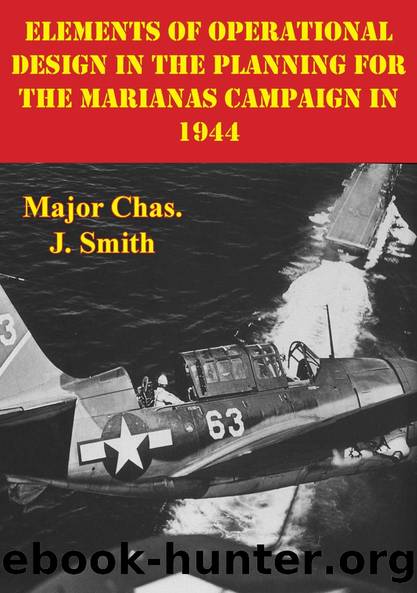Elements Of Operational Design In The Planning For The Marianas Campaign In 1944 by Major Chas. J. Smith

Author:Major Chas. J. Smith [Smith, Major Chas. J.]
Language: eng
Format: epub
ISBN: 9781786253613
Barnesnoble:
Publisher: Verdun Press
Published: 2015-11-06T00:00:00+00:00
EXECUTING OPERATION FORAGER
The South West Pacific Area launched preliminary strikes and reconnaissance missions with land based USAAF aircraft on 3 June which continued for over a week. The attacks focused on the islands south of the Marianas and caused some serendipitous deception. Actions of the SWPA forces reinforced the Japanese expectation that the next major attack would be in the south. They attempted to reinforce these areas and suffered losses that weakened potential forces for the Marianas. Because the Japanese did not sense the danger in the Marianas, several convoys were moving through the area and were relatively unprotected. Elements of TF 58 attacked the convoys on 12 June and sunk 12 cargo ships, three submarine chasers, and a PT boat.{141}
Admiral Mitscher accelerated the timing and tempo of the operation. He was in position and asked Spruance for permission to conduct a fighter sweep one day earlier than the planned strikes. Spruance granted the request and Operation Forager began on the afternoon of 11 June. The fighter sweep resulted in a crippling blow to one of the Japanese critical nodes four days before the scheduled amphibious landing. The early strike reduced the Japanese land-based air strength by roughly 30 percent, destroying approximately 150 planes.{142}
The planned strikes to effect Japanese critical nodes commenced on 12 June and continued on the 13th. The effects of the three days of bombardment were noticeable by Japanese actions. Hoffman notes, âWith most of their planes either burned on the ground or missing in action, the Japanese responded only with sporadic dusk and night attacks during this preliminary phase of the operation.â{143} The air strikes continued simultaneously against several islands and in depth. Morison remarks that, âOn 13 June, two days before D-day, United States carrier-based planes were swarming all over the islands, looking for parked planes or targets of opportunity.â{144} The strikes decreased in tempo against the Marianas on the 14th and 15th because of the scheduled resupply operations and the planned focus shifted north; however, by this time Japanese land based air strength was negligible. The Task Force 56 After Action Report on Operation Forager adds, âPreliminary air strikes and air support during the operations on SAIPAN, GUAM, and TINIAN proved so effective that complete dominance of the air was gained prior to D-Day.â{145} Morison notes, âIt was symptomatic of the feeble enemy air strength in and around the Marianas that no more air attacks were directed at the fast carriers until the evening of D-day, the 15th.â{146} The Strikes against Iwo and Chichi Jima on 15-16 June destroyed an additional 101 Japanese planes.{147}
The naval bombardment commenced on 13 June and initially demonstrated some flaws in the plan. Two critical factors led to ineffective fires on this day. The first was the integration of minesweepers. The plan directed minesweeping operations and air cover; however, it did not allow the ships enough time to get into position and complete the task. The battleships were also floating antiaircraft batteries and had to maintain a position to protect the escort carriers.
Download
This site does not store any files on its server. We only index and link to content provided by other sites. Please contact the content providers to delete copyright contents if any and email us, we'll remove relevant links or contents immediately.
| Central Asia | Southeast Asia |
| China | Hong Kong |
| India | Japan |
| Korea | Pakistan |
| Philippines | Russia |
The Sympathizer by Viet Thanh Nguyen(4308)
The Rape of Nanking by Iris Chang(4140)
World without end by Ken Follett(3432)
Ants Among Elephants by Sujatha Gidla(3417)
Blood and Sand by Alex Von Tunzelmann(3140)
Japanese Design by Patricia J. Graham(3112)
City of Djinns: a year in Delhi by William Dalrymple(2516)
The Queen of Nothing by Holly Black(2499)
Foreign Devils on the Silk Road: The Search for the Lost Treasures of Central Asia by Peter Hopkirk(2435)
India's Ancient Past by R.S. Sharma(2417)
Inglorious Empire by Shashi Tharoor(2396)
Tokyo by Rob Goss(2390)
In Order to Live: A North Korean Girl's Journey to Freedom by Yeonmi Park(2348)
India's biggest cover-up by Dhar Anuj(2319)
Tokyo Geek's Guide: Manga, Anime, Gaming, Cosplay, Toys, Idols & More - The Ultimate Guide to Japan's Otaku Culture by Simone Gianni(2316)
The Great Game: On Secret Service in High Asia by Peter Hopkirk(2305)
Goodbye Madame Butterfly(2209)
Batik by Rudolf Smend(2128)
Living Silence in Burma by Christina Fink(2038)
